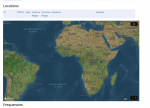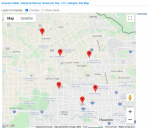Thank you all!
I went over the area list and did see (barely) the fine print "simulcast". But as indicated, clicking on the FCC license is a sure indicator.
Not always.
Take a look at this license. This is for an electric utility co-op that I was looking at in a conversation with a member who wanted to monitor the system.
FCC Callsign WQSR647 (ESCAMBIA RIVER ELECTRIC COOP)
www.radioreference.com
At first glance, the site map would lead you to believe it's simulcast:

But, if you look at the site details actually in the license, you'll see that each site has a different set of frequencies.
Now, look at this site, from a different system:
Lower Colorado River Authority (LCRA) P25 Site: Brownwood Details
www.radioreference.com
If you click on the license, you get this map:

This site uses frequencies from a blanket license issued to the state, so there is no license for this specific set of frequencies to indicate their site location(s).
Sometimes, these sites may be licensed as 'Simulcast' in the database, but without definitive license detail to verify, there is no way to verify if the site is, or is not, simulcast, and if simulcast, where the actual transmit towers are located.
Now, look at this site from your Houston Metro area:

Click on the small icon (highlighted) near the lower left corner of the coverage map:

That indicates the actual transmit tower locations associated with the license.





